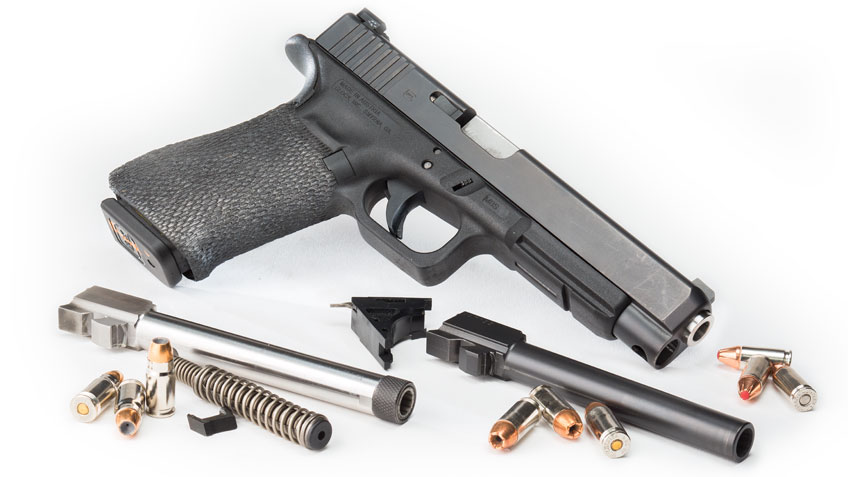
This Glock G35 got the author thinking about making guns multi-caliber capable and avoiding ammo panics.
As this is being written, we have just experienced a presidential election many feared would end in the election of an outspokenly anti-gun POTUS and signal the beginning of a new round of coordinated assaults on the right to keep and bear arms. Fortunately, we seem to have dodged that bullet, but I know that many of my friends were anticipating an ammunition-buying panic that would have made the Great Ammo Panics of ‘08 and ‘13 look like mere supply-chain hiccups.
During the first of those panics, I was caught embarrassingly flat-footed. Fortunately, I’d been squirreling away certain kinds of ammunition in the compulsive hoarding fashion that only people who love odd calibers can really understand.
Those haven’t been the only modern ammo shortages, either. We’ve experienced droughts of certain calibers just due to the whims of the market, or the sudden growth in popularity of one round or another.
It was with thoughts of these situations that I made an impulse purchase of a former co-worker’s Gen4 Glock 35. It wasn’t so much that I wanted the gun, although it was a nice, lightly customized Glock, but the fact that he was selling it with a second barrel in 9 mm and the corresponding ejector, extractor, and recoil spring assembly to go with it. Once I had it, I bought a third barrel: an aftermarket conversion barrel chambered in the effective but not very popular .357 SIG.
With a pistol that could use three of the most common service calibers of the last several decades, it was unlikely that any particular shortage would dry up the supply of usable commercial ammunition. If I were a classic old-school gunwriter, I’d have a cool name for it, like “The Chimera” or “Cerberus,” but I’m not, and so it’s just “That Glock I bought with a couple extra barrels.”
With SIG Sauer’s P250 or P320 guns, the same effect can be achieved to an even greater extent with factory conversion kits. For less than the price of a used gun, you can add not only the ability to fire a different caliber, but also change the size and form of these modular, polymer-frame pistols.
It can be harder with a classic 1911-pattern pistol, but if the gun’s chambered in .38 Super or 10 mm, you can fire 9 mm or .40 S&W, respectively, by the simple expedient of a second barrel (and vice versa, of course.)
There are also options for various semi-wildcat or proprietary chamberings: .45 ACP guns can benefit from .460 Rowland, .45 Super, .40 Super, or .400 Cor-Bon conversions, while 10 mm has 9x25 Dillon and .38 Super (or 9 mm if it’s in a 1911) has .22 TCM. Heck, many .380 ACP pistols can be swapped to the .32 NAA cartridge with the simple exchange of an aftermarket barrel.
Throw in a rimfire top end for any of these guns and you’ve made the gun dramatically more omnivorous.
With some classic pocket pistols, like the later Colt Pocket Hammerless guns or the FN Herstal 1910, the difference between the .32 ACP and .380 ACP versions is literally just the barrel and magazine, and the magazine is even interchangeable past a certain vintage on some.
There are ways to broaden the appetite of revolvers, too. I know, I know; revolver ammo isn’t affected by panics because revolver owners don’t panic. Still, consider some of the cool options available now.
For instance, these days I’d be strongly inclined to send any .45 Colt or .454 Casull revolver in to TK Customs for a conversion to take .45 ACP in moon clips. Similarly, the company will machine certain .38 Spl./.357 Mag. revolvers from Smith & Wesson and Ruger to fire standard-pressure 9 mm from moon clips.
If the revolver is a single-action, a good gunsmith can take a cylinder blank and hook you up with a second cylinder set up to fire rimless cartridges of the same bore size.
While there’s always the option of just up and buying another handgun in the desired caliber, in some jurisdictions that’s a lot more hassle than just adding the ability to fire another chambering to an existing handgun. Further, if one has performed modifications to a favorite handgun such as new sights or trigger work, they will all carry over to the new chambering without having to send a whole ‘nother gun off to the gunsmith and wait to have it made identical to your beloved pistol.
Versatility is a good thing and, besides, if the Zombie Apocalypse happens and down at the gun store all the shelves have been stripped bare except for one dusty box of .357 SIG frangibles and you don’t have anything that will shoot it, well aren’t you going to feel a little embarrassed?




































